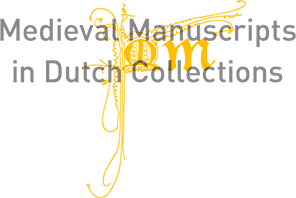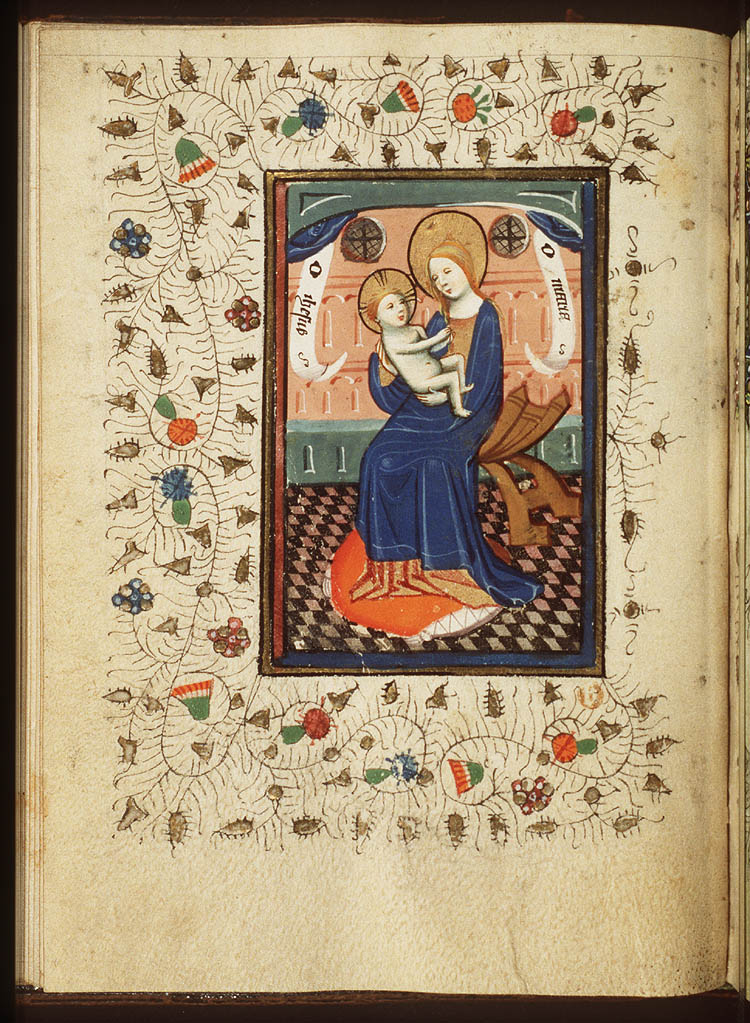Stamped miniatures
Book of hours. Latin. Parchment, 99 ff. 150x110 (83x62) mm. Bruges, c. 1430-1450. The Hague, KB : ms. 135 K 45
On April 1, 1427 the council of
So far, we have been able to trace 25 manuscripts - all books of hours - as well as four single leaves, with stamped miniatures that can be connected with the requirement. All can be dated around the second quarter of the fifteenth century. The stamps are all black, red, or brownish circles, about 4-5 mm in diameter, containing crosses, stars, letters, lions, fleur-de-lys and clovers.
This book of hours contains twelve single-leaf miniatures, all stamped with a brownish circle in which a small gothic b is left blank. The miniatures are painted by an anonymous illuminator who, regarding the style of his work, must be one of the Masters of Otto van Moerdrecht. This group of illuminators contained many ateliers, who worked in several Dutch cities in the first half of the fifteenth century. The master we are dealing with worked in the city of
The
Literature
· Wilhelmina (Saskia) van Bergen, De Meesters van Otto van Moerdrecht : een onderzoek naar de stijl en iconografie van een groep miniaturisten, in relatie tot de productie van getijdenboeken in Brugge rond 1430, unpublished doctoral thesis, Universiteit van Amsterdam 2007
· A.S. Korteweg, `Middeleeuwse handschriften'. In: Accoord. C.R. Een keuze uit de bijzondere aanwinsten verworven tijdens het bibliothecariaat van dr. C. Reedijk. Tentoonstellingscatalogus. Koninklijke Bibliotheek. 's-Gravenhage 1986, p. 26-52. p. 25, 40 nr. 16, afb. 26
See also
-
A psalter from Royal libraries
Psalter. Latin, Parchment, 185 ff., 245x177 mm. Northern England, 1190-1200. Leiden, UB : ms. BPL 76 A
-
Flemish surgical instruments
Small manual for a surgeon, based on the Cyrurgie by Meester Jan Yperman (incomplete). Flemish. Paper, 130x95 mm. Flanders, last quarter of the 15th century. Leiden, UB : ms. BPL 3094
-
The Zwolle bible
Bible. Latin. Parchment, 6 volumes, c. 530x390 mm. Brethren of the Common Life, Zwolle, 1464-1476. Utrecht, UB : Cat 31 and 15.C.11
-
The Utrecht Psalter
Psalter. Latin. Parchment, 91 ff., 330x255 mm. Benedictine monastery of St. Peter, Hautvillers near Reims, c. 820-835. Utrecht, UB : Cat. 32 / 1
- All articles in Highlights


